Utiliser SCIM avec Ideanote
Note: This guide is intended for Workspace owners
SCIM (System for Cross-domain Identity Management) is an open standard that allows for the automation of user provisioning between software systems, such as between your IT-infrastructure and the Ideanote platform. It enables you to create, update, disable, and delete users and teams from within your own system, such as from a Microsoft Entra ID/Azure AD application you’ve set up internally for usage with Ideanote.
With SCIM, you can prepare all of your users, teams, and their memberships within these teams, from within your own system, such that everything is synced with Ideanote and ready for when you want to launch a campaign, - without you having to ask your users to join the platform in advance.
If you combine SCIM with SAML- or OIDC-based authentication, both user provisioning and user authentication is fully driven by your own IT-infrastructure.
Ideanote is fully compliant with the SCIM standard, and supports all required as well as many of the optional SCIM attributes for both Users and Groups. All of these are discoverable via our public API via standardized endpoints, as well as directly from within the Ideanote platform.
This guide will help you get started with SCIM on Ideanote as easily as possible.
We’ll be using Microsoft Entra ID (formerly known as Azure Active Directory) for the examples in this guide, but the principles should apply to any identity provider that is SCIM-compliant.
1) First, go to your Ideanote Workspace.
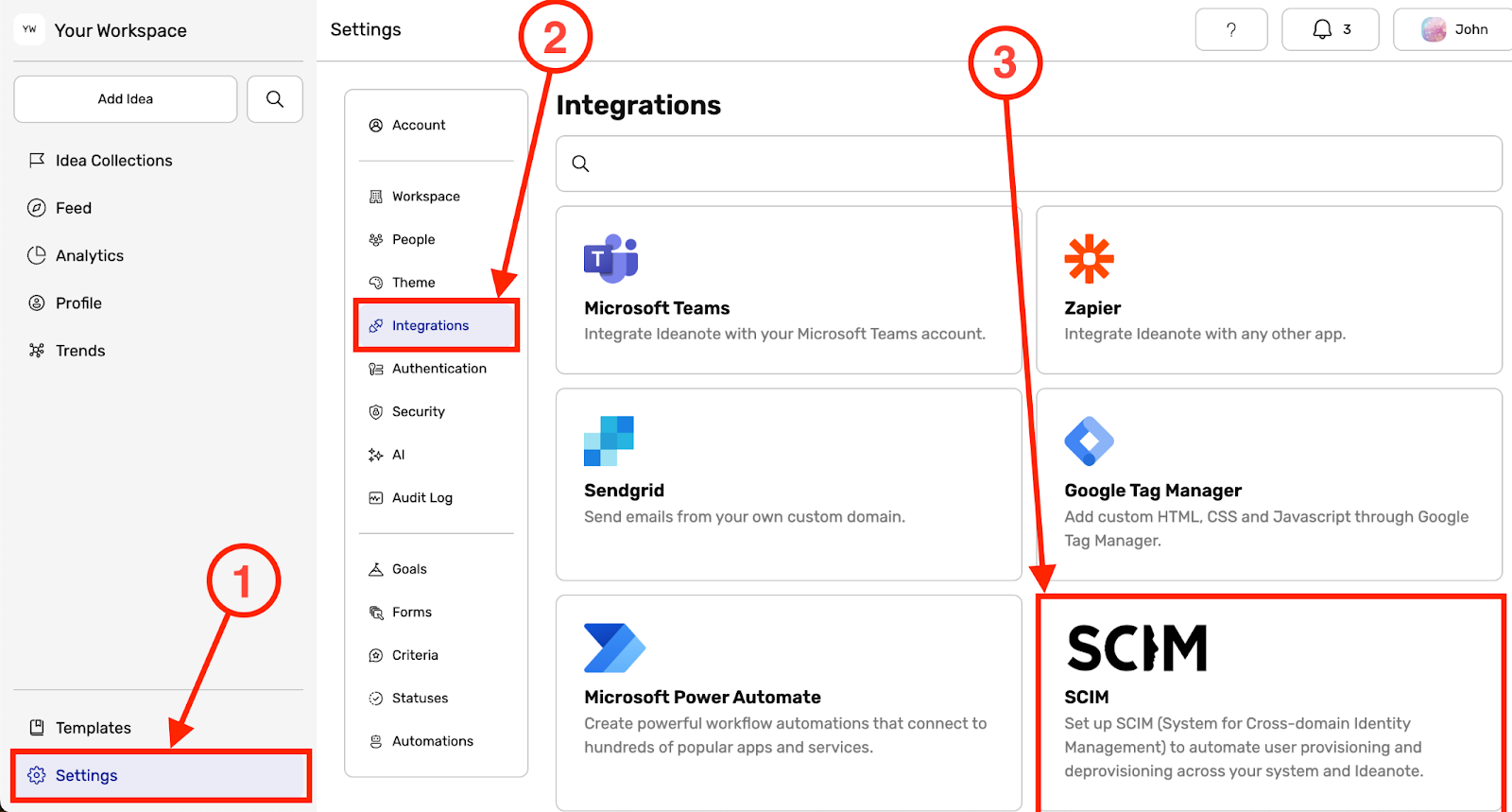
1.1) Click ‘Settings’ in the main sidebar
1.2) Click ‘Integrations’
1.3) Click ‘SCIM’
2) A dialog window will now appear on your screen with information relating to your SCIM configuration. It is immediately ready to be used.

2.1) In the top of the dialog, you will be able to see whether or not Ideanote has received an API-request using this configuration yet (See 1 in the image above).
2.1.1) When everything is set up correctly and an API request has been received, the text and the color of the indicator will be different, as seen in the image below:

2.2) The ‘Tenant URL’ is the root of Ideanote's SCIM endpoints. You will need to add this to the application you will set up for Ideanote in your identity provider later.
2.3) The ‘Secret Token’ is the token needed to authenticate calls to Ideanote's SCIM endpoints. You will need to add this to the application will set up for Ideanote in your identity provider later.
2.4) The ‘Supported User Attributes’ accordion menu expands into a table of all the SCIM attributes Ideanote supports for SCIM Users, including our own schema extensions. This data comes directly from our API on runtime and is therefore always 100% up-to-date.
2.5) The ‘Supported Group Attributes’ accordion menu expands into a table of all the SCIM attributes Ideanote supports for SCIM Groups. As described in step 2.4, this data is always 100% up-to-date.
2.6) Note: If you want to delete a SCIM configuration, click ‘Delete SCIM-Configuration’.
3) You’ve now set your Workspace up for SCIM. Next, go to the place from which you manage the users and/or IT-infrastructure in your organization, such as Microsoft Entra ID.
4) From Microsoft Entra ID, or from the Azure Portal, click on ‘Enterprise applications’.
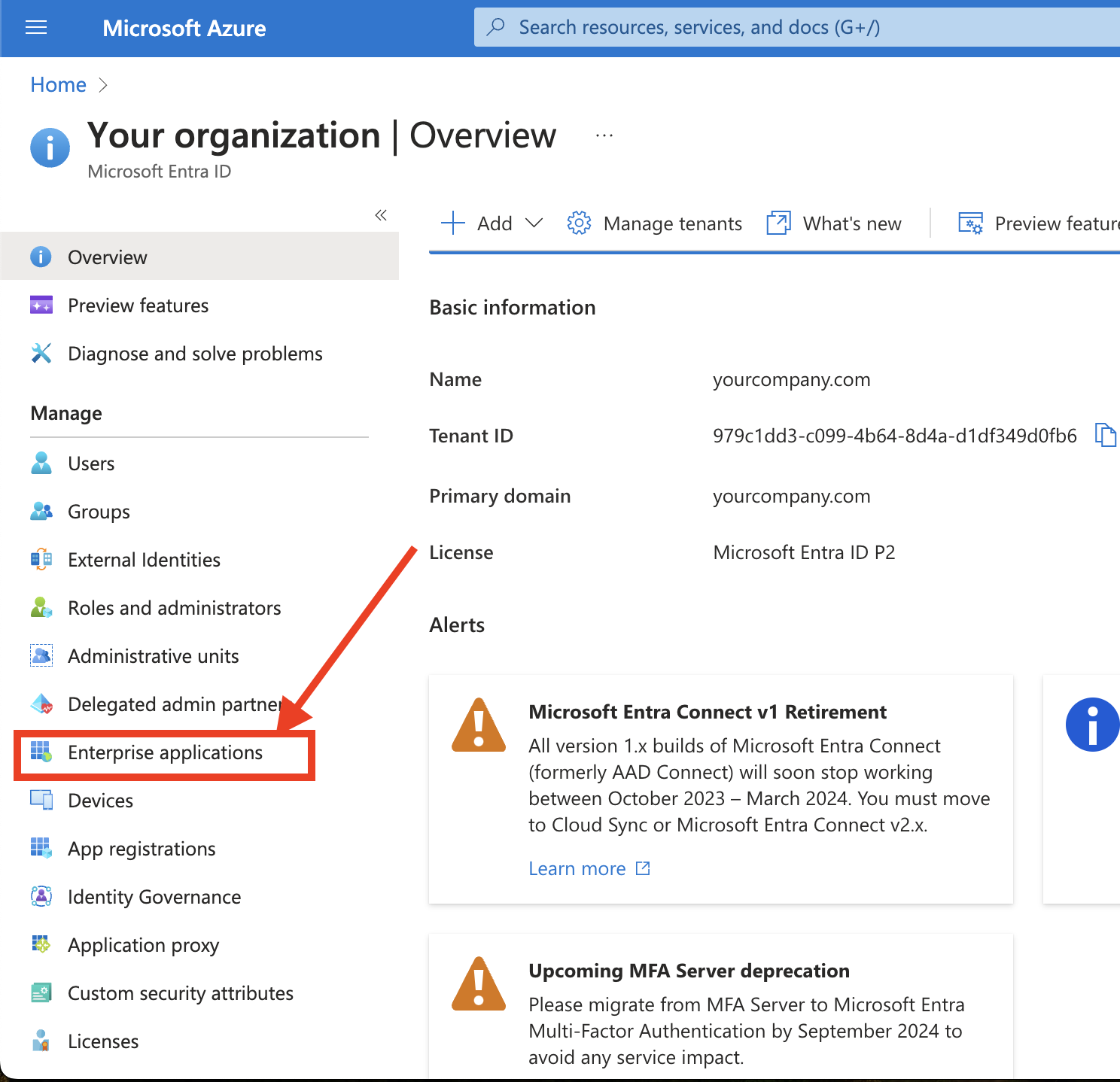
5) If you have already created an Enterprise application for Ideanote in the past, such as for SAML-/OIDC-based authentication, find it in the list, click on it, and go directly to step 7. Otherwise, click ‘New application’.

6) You’ll now be taken to a gallery of existing apps, but will be creating a new one:
.
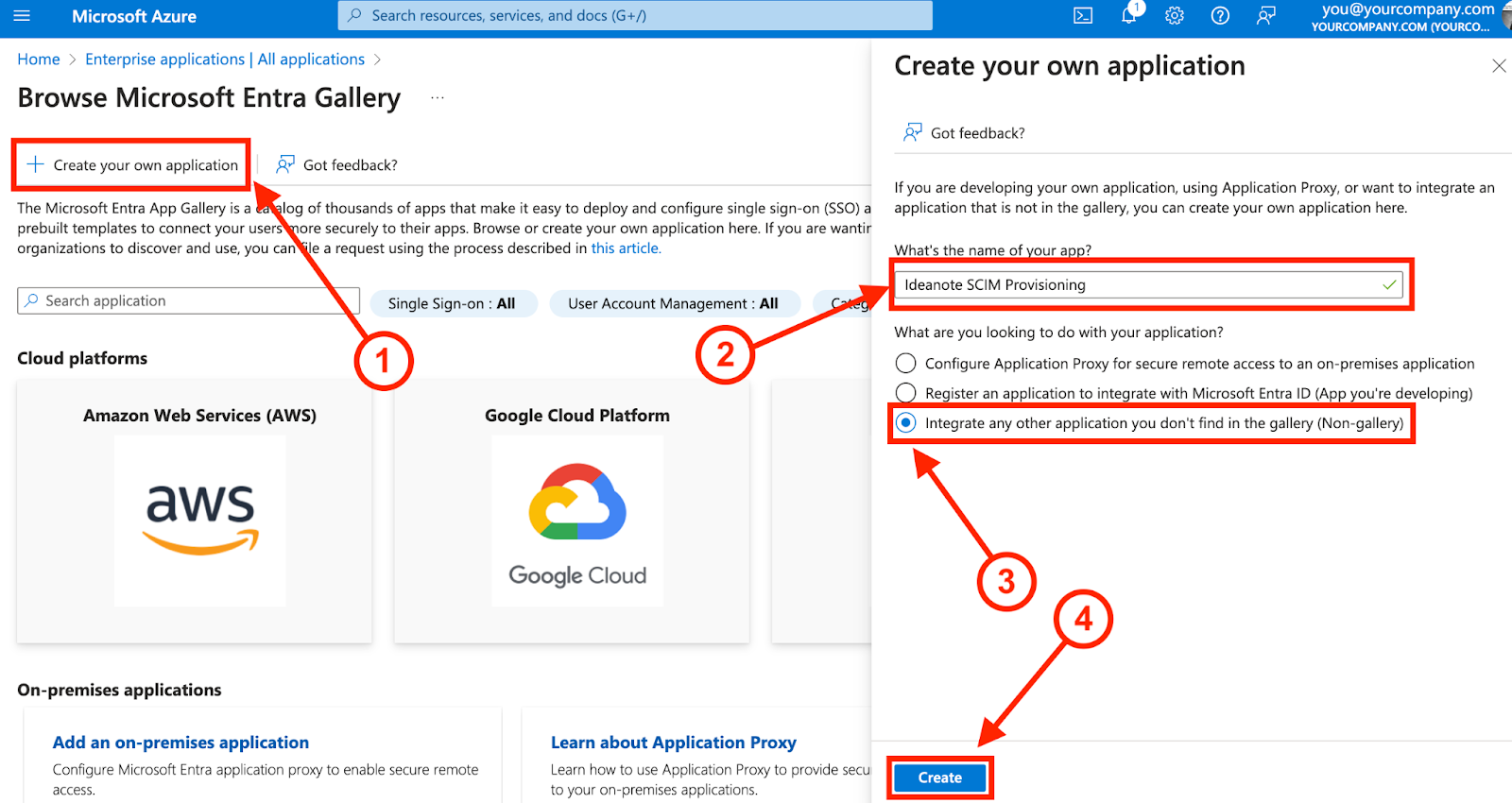
6.1) Click ‘Create your own application’
6.2) Under ‘What’s the name of your app?’, give it a fitting name, such as ‘Ideanote SCIM provisioning’.
6.3) Under ‘What are you looking to do with your application’, select ‘Integrate any other application you don’t find in the gallery (Non-gallery)’.
6.4) Click ‘Create’ to proceed. You will now be taken to your new Enterprise application.
7) From your application, click ‘Provisioning’ in the sidebar under ‘Manage’
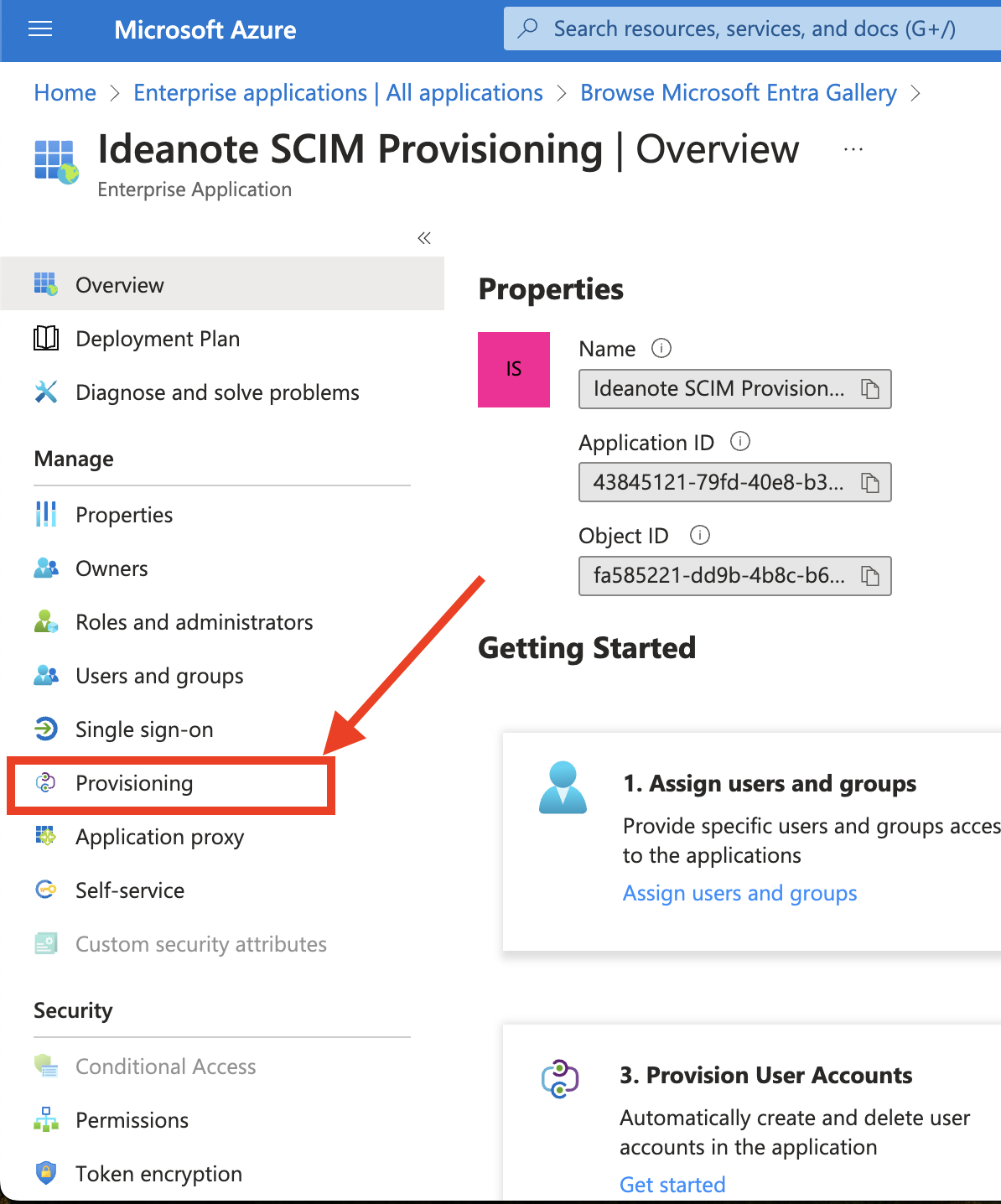
8) Click ‘Get started’

9) We now have to connect the information from the SCIM configuration you’ve set up on your Ideanote workspace to your Enterprise application:
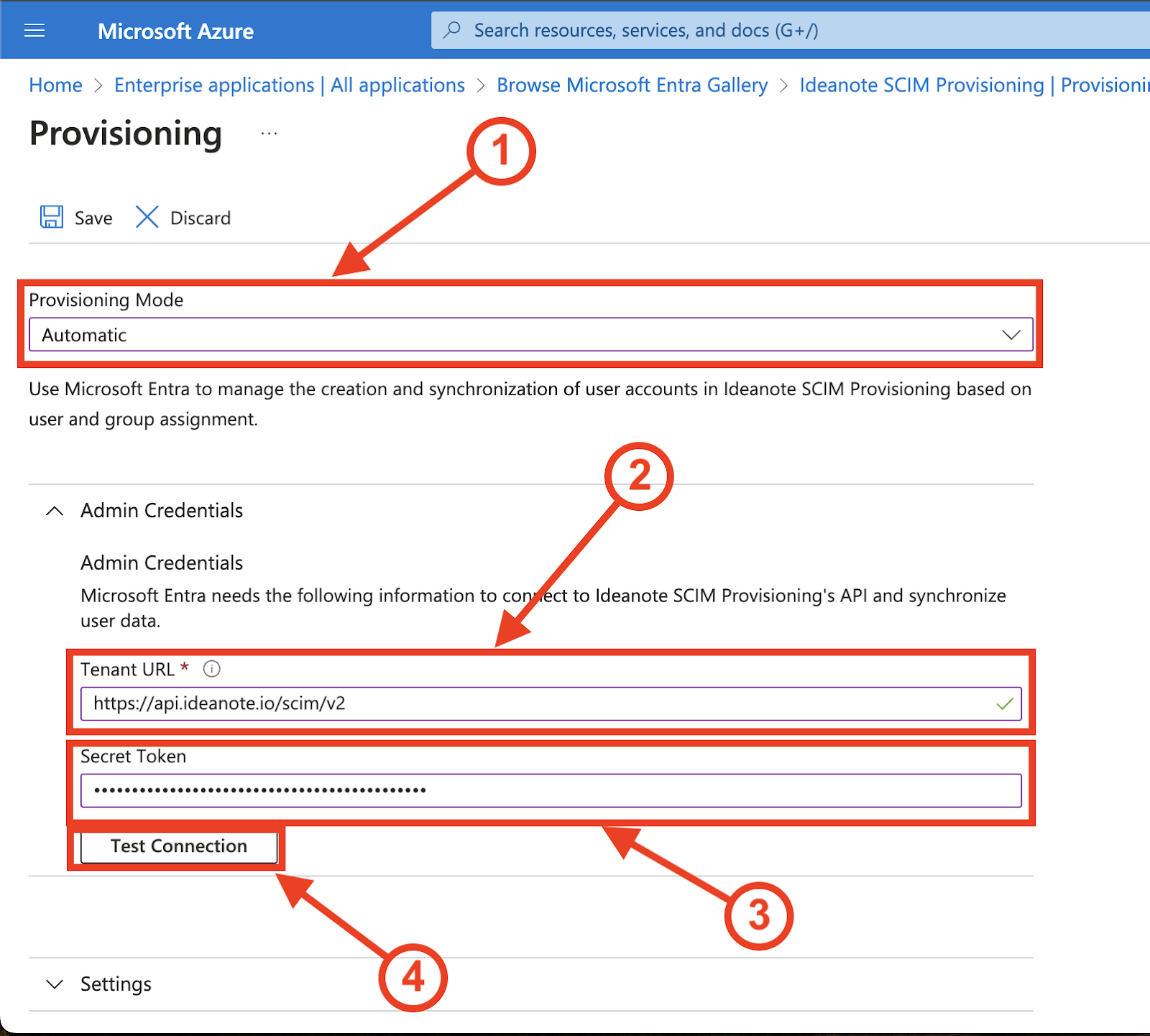
9.1) Under ‘Provisioning Mode’, change to ‘Automatic’. “Admin Credentials” will now appear below it. Make sure it is expanded.
9.2) Under ‘Tenant URL’, insert the URL you received in step 2.2 in the SCIM Integration dialog on your Ideanote Workspace.
9.3) Under ‘Secret Token’, insert the token you received in step 2.3 in the SCIM Integration dialog on your Ideanote Workspace.
9.4) Finally, click ‘Test Connection’ to ensure that it is working correctly.
9.4.1) If everything goes correctly, you should see the following message.

9.4.2) You should now also be able to see on the SCIM configuration in your Ideanote workspace that the text and color of the indicator described in step 2.1 has changed into something like seen on the following image:

9.5) Click ‘Save’ to save the credentials.
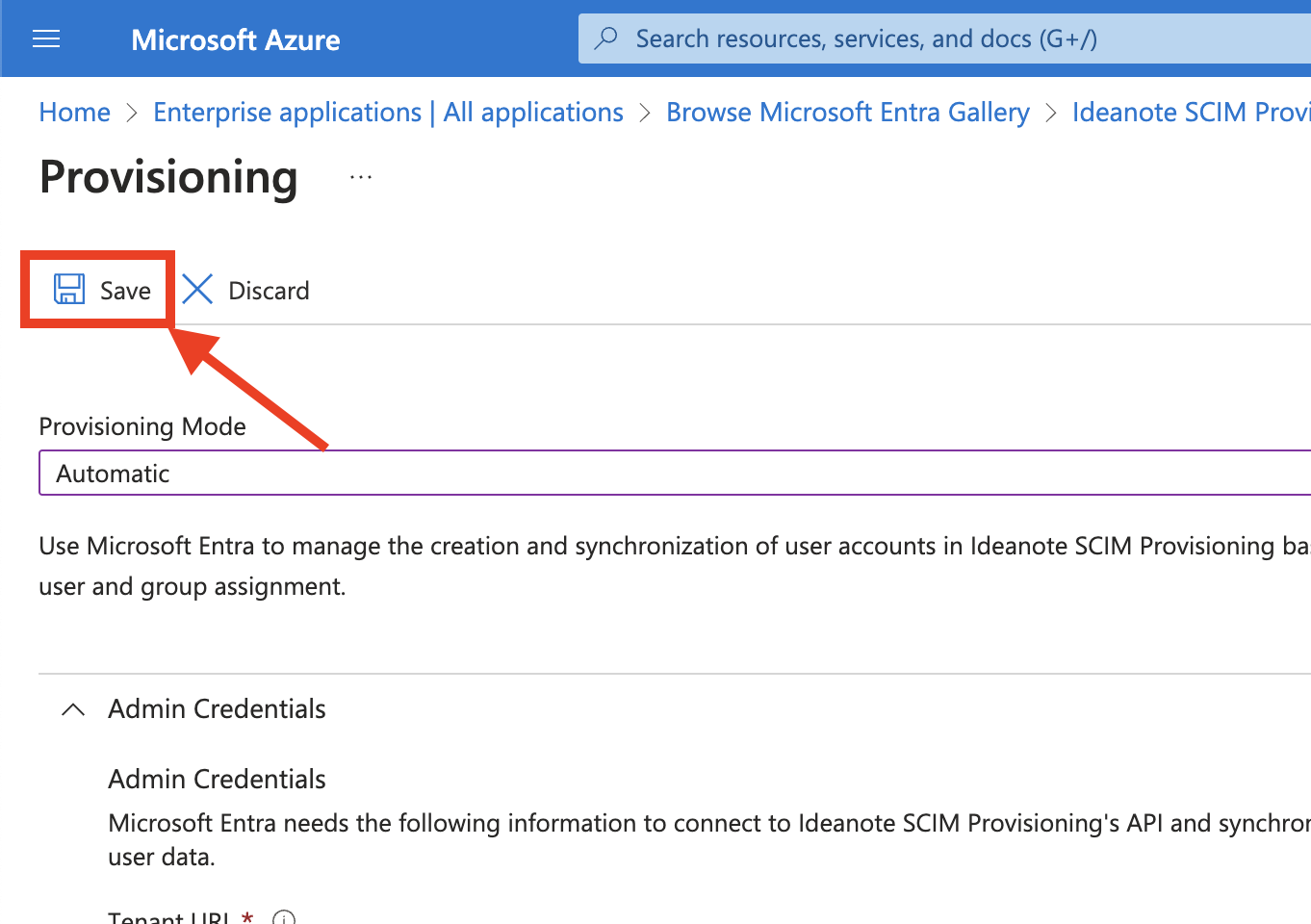
9.6) Now you should review and potentially customize how your user- and group data is mapped to corresponding SCIM attributes:
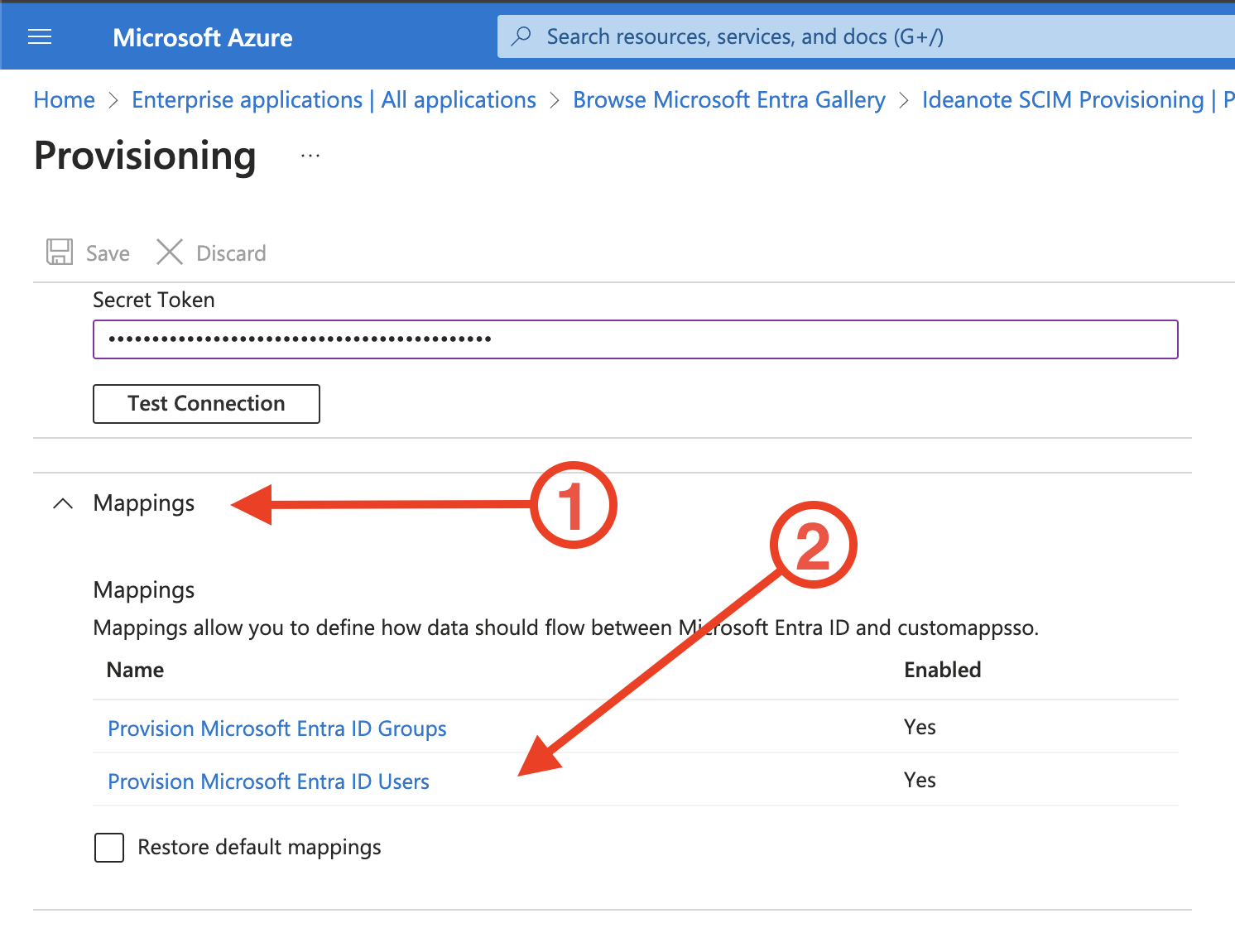
9.6.1) Make sure the ‘Mappings’ accordion menu is expanded
9.6.2) Click in ‘Provision Microsoft Entra ID Users’
9.7) You’ll now be taken to ‘Attribute Mapping’. Azure comes with default mappings that work out of the box, but you are free to customize this as you want. For example, you might want to map the specific roles you assign to your users inside Entra ID to equivalent Ideanote ranks, and/or you might want to map something else than mailNickname to externalId, such as the userPrincipalName. You can use the table of ‘Supported User Attributes’ outlined in step 2.4 to get an overview of the User attributes Ideanote supports.

9.7.1) Si vous souhaitez mapper à l'un des attributs d'extension de schéma utilisateur d'Ideanote, tel que TeamPath, vous devez l'ajouter à la liste des attributs de l'application Enterprise :

9.7.1.1) Assurez-vous « Afficher les options avancées » est coché
9.7.1.2) Cliquez « Modifier la liste d'attributs pour customappsso » (ou quel que soit le nom de l'application)
9.7.1.3) Faites défiler la page vers le bas et saisissez le nom de l'attribut auquel vous souhaitez mapper, par exemple URN:IETF:Params:Scim:Schemas:Extension:IdeaNote:2.0:User:TeamPath

9.7.1.4) Cliquez sur « Enregistrer » pour valider vos modifications
9.7.2) Si vous souhaitez ajouter un mappage supplémentaire, cliquez sur « Ajouter un nouveau mappage ». Vous pouvez consulter la documentation complète de Microsoft sur le mappage des attributs ici.
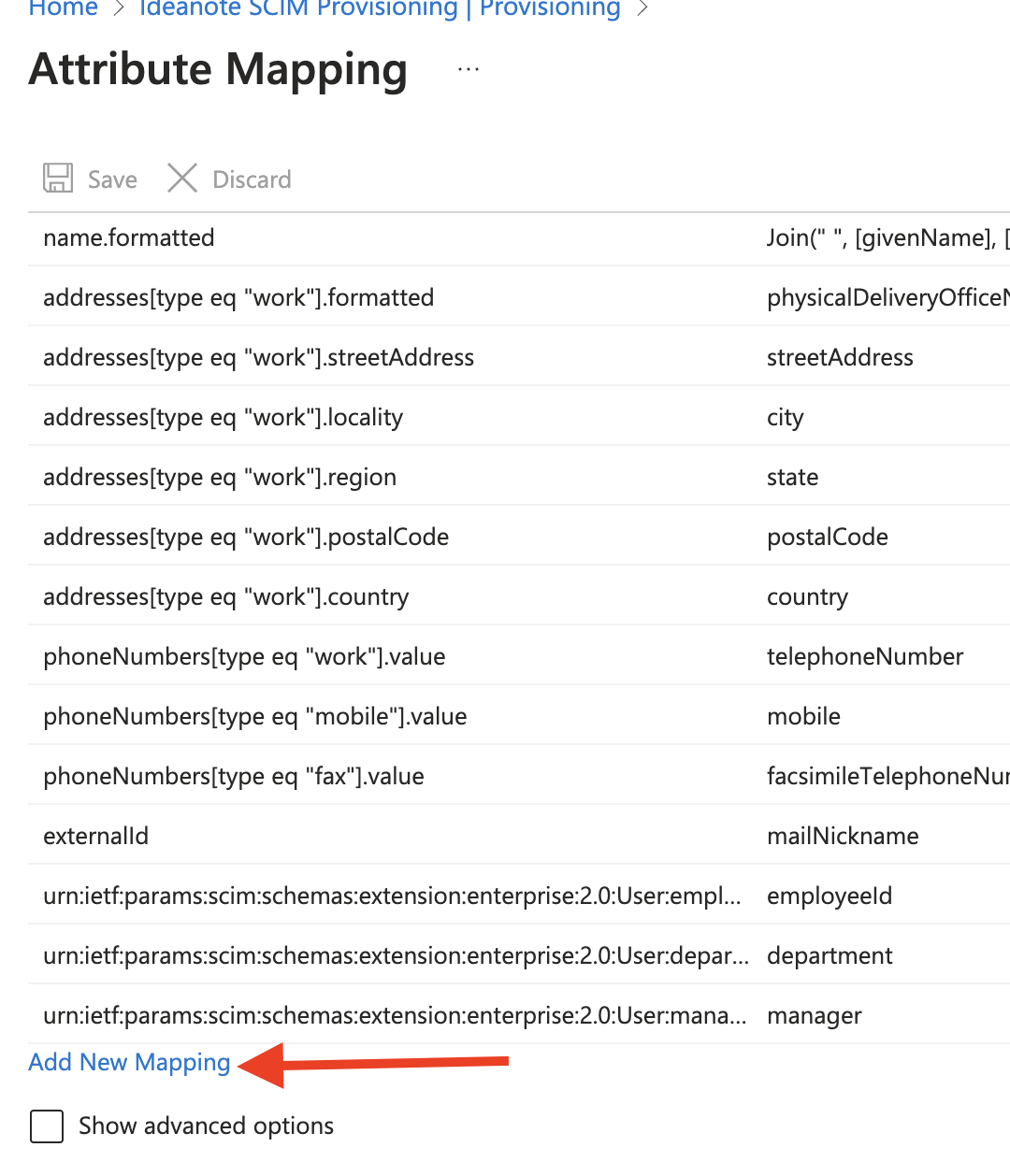
9.8) Vous êtes maintenant prêt à ajouter les utilisateurs et les groupes que vous souhaitez associer à Ideanote et mettre à disposition avec SCIM.
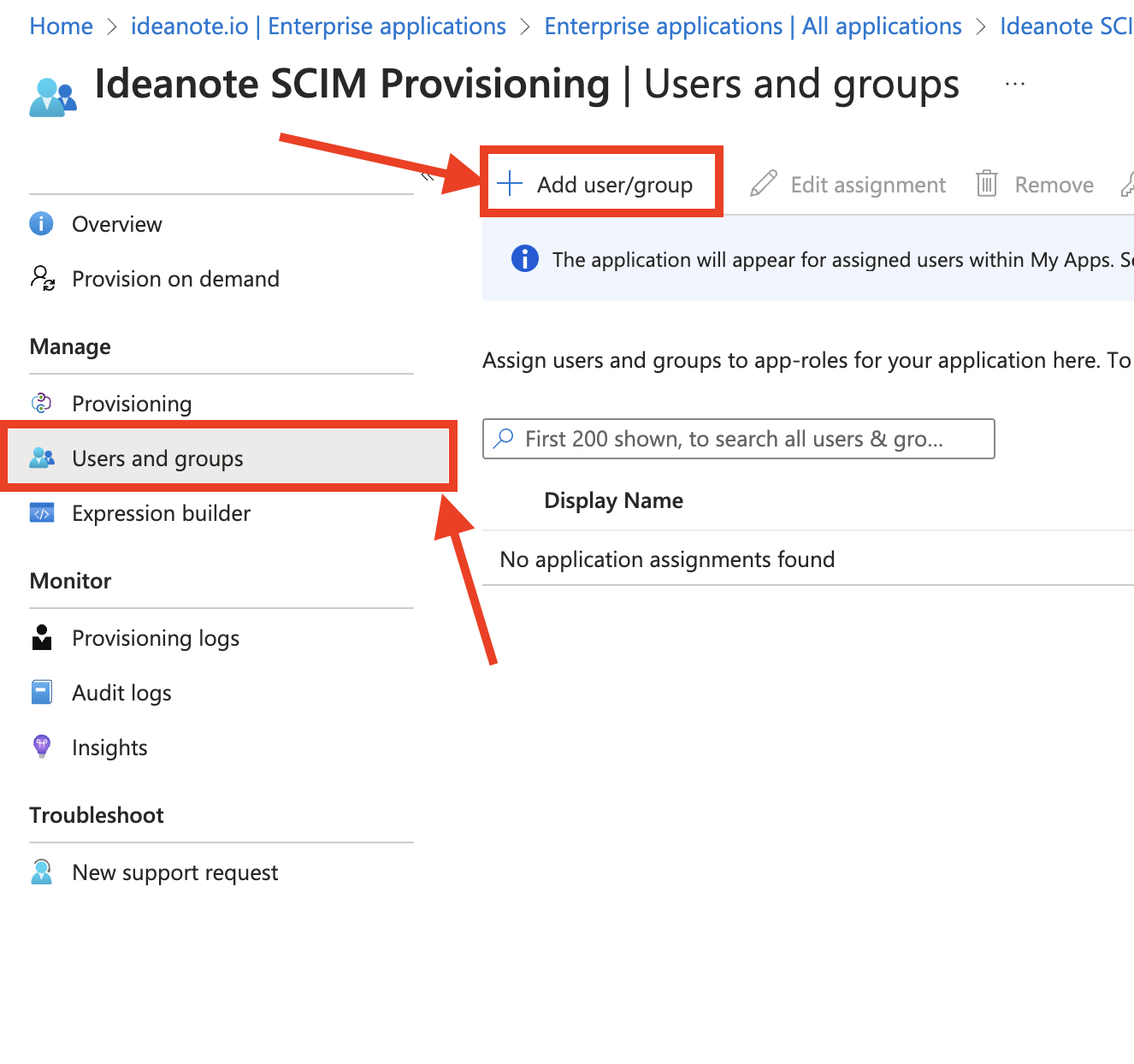
9.8.1) Cliquez « Utilisateurs et groupes »
9.8.2) Cliquez « Ajouter un utilisateur/un groupe »

9.8.2.1) Sous « Utilisateurs et groupes », cliquez « Aucun sélectionné »
9.8.2.2) Recherchez les utilisateurs et/ou les groupes que vous souhaitez ajouter.
9.8.2.3) Cliquez « Sélectionner » pour ajouter les utilisateurs sélectionnés à l'application.
9.9) Vous avez maintenant configuré le provisionnement SCIM avec succès ! Microsoft Entra ID approvisionnera automatiquement vos utilisateurs et vos groupes à intervalles fixes. Si vous souhaitez d'abord tester ce provisionnement, vous pouvez provisionner un utilisateur ou un groupe à la demande :
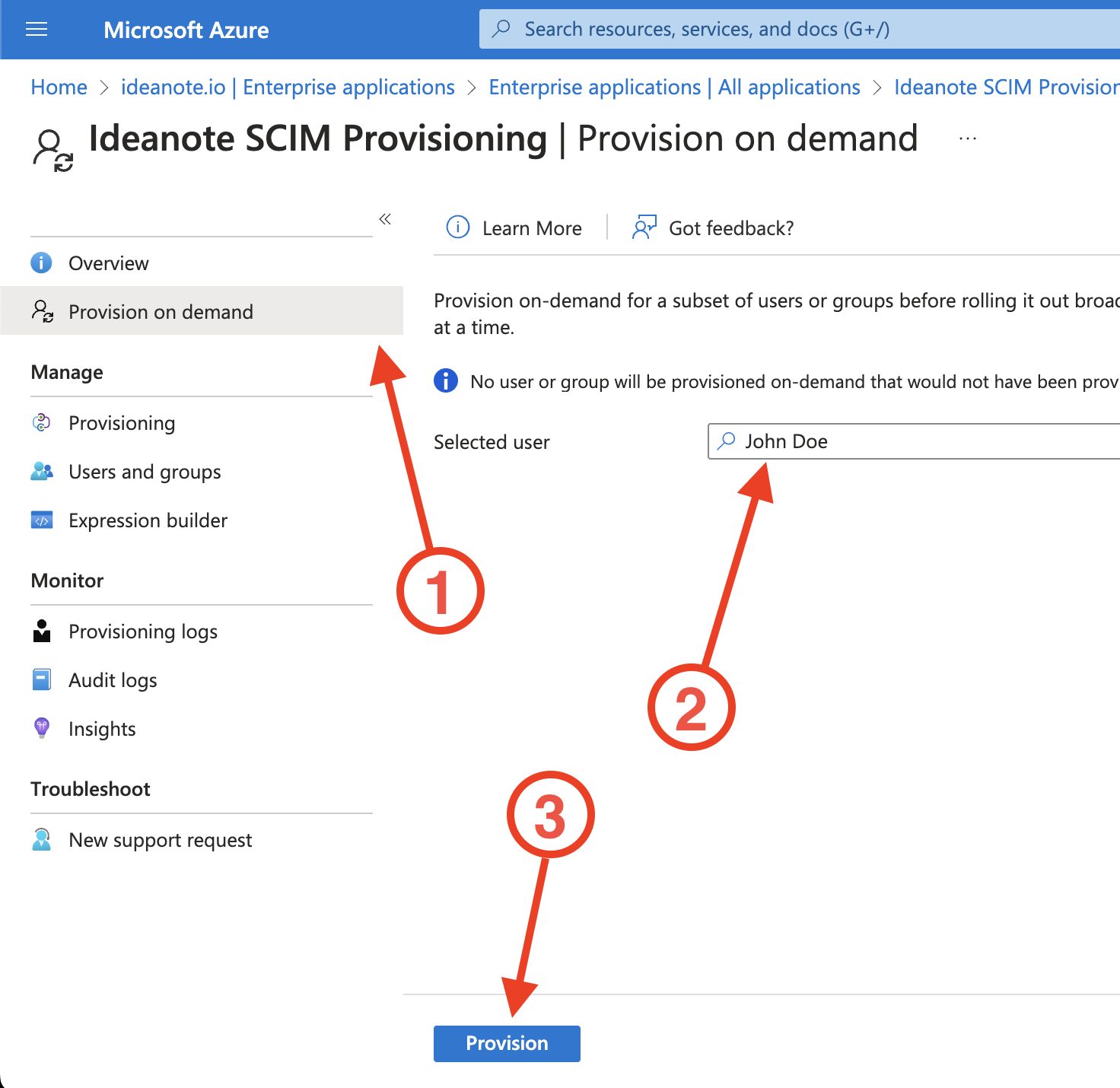
9.9.1) Cliquez « Fourniture à la demande »
9.9.2) Sous « Utilisateur sélectionné », recherchez l'utilisateur ou le groupe que vous souhaitez approvisionner
9.9.3) Cliquez « Provision » pour fournir à l'utilisateur
9.9.4) Si vous avez sélectionné un utilisateur, celui-ci devrait maintenant apparaître dans la page des paramètres « Personnes » de votre espace de travail Ideanote. Si vous avez sélectionné un groupe, il devrait maintenant apparaître en tant qu'équipe dans l'onglet « Équipes ».
9.10) Vous avez maintenant configuré SCIM avec succès et configuré votre premier utilisateur !
9.11) Vous pouvez voir quand un utilisateur a été synchronisé pour la dernière fois avec SCIM, ainsi que son identifiant externe, sur la page des paramètres « Personnes » de votre espace de travail Ideanote :

9.11.1) Accédez à la colonne visible la plus à droite du tableau et cliquez sur les trois points horizontaux (...)
9.11.2) Assurez-vous que »Synchronisé avec SCIM à ' et/ou « Identifiant externe SCIM » est cochée pour qu'ils apparaissent dans le tableau.
9.12) Microsoft Entra ID se chargera de synchroniser les modifications apportées à Ideanote au fil du temps à intervalles fixes. Lorsque vous supprimez un utilisateur d'Entra ID, il est également supprimé de votre espace de travail Ideanote. Quand tu annuler l'attribution un utilisateur de l'application d'entreprise que vous avez créée pour le provisionnement SCIM, l'utilisateur sera à la place handicapé dans Ideanote. Ceci est régi par les règles décrites par Microsoft dans cet article dans la section « Événements de déprovisionnement ».



